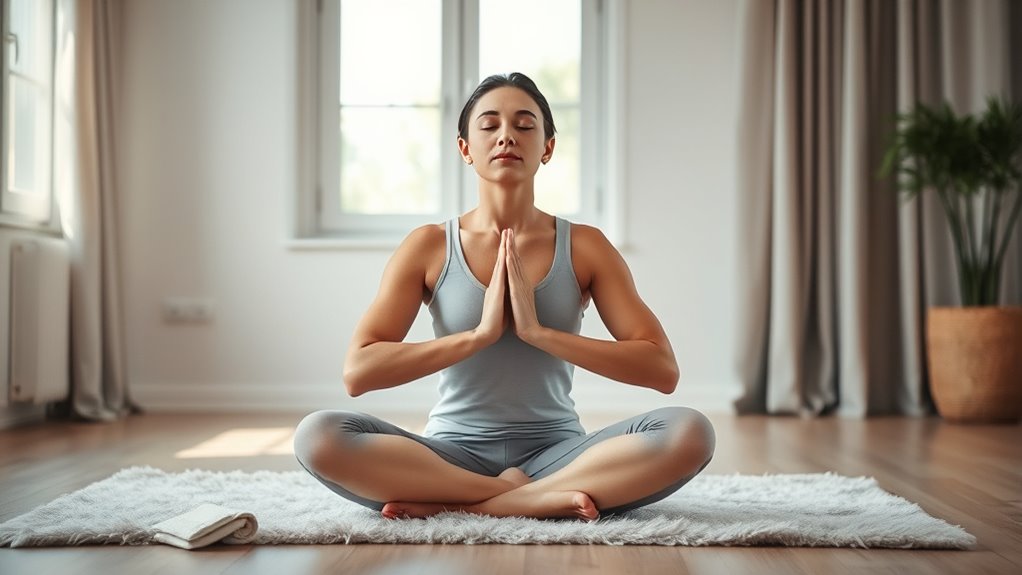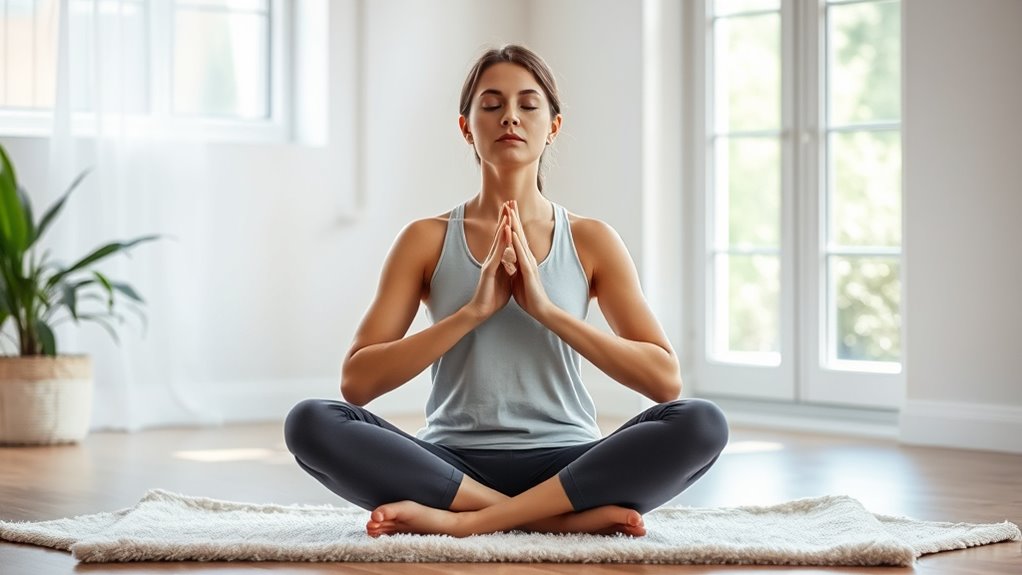To boost your lung capacity, try diaphragmatic breathing by expanding your belly as you breathe deeply through your nose. Practice pursed-lip breathing to improve airflow and manage shortness of breath. Use box breathing to calm your nervous system with rhythmic inhaling, holding, and exhaling. Incorporate deep breath holds and alternate nostril breathing to strengthen lungs and balance your nerves. Keep practicing these techniques regularly, and you’ll discover more ways to enhance your respiratory health.
Key Takeaways
- Practice diaphragmatic breathing regularly to strengthen the diaphragm and increase lung capacity.
- Incorporate deep breathing with breath holds to enhance respiratory muscle strength and lung volume.
- Use pursed-lip breathing to improve airflow efficiency and prevent airway collapse during exhalation.
- Perform box breathing exercises to promote controlled, steady breaths and expand lung capacity over time.
- Engage in alternate nostril breathing to balance the nervous system and optimize oxygen intake.
Diaphragmatic Breathing Technique

Diaphragmatic breathing, also known as belly breathing, is a simple yet powerful technique that enhances your lung capacity and reduces stress. To practice, sit or lie down in a comfortable position. Place one hand on your chest and the other on your belly. Inhale deeply through your nose, allowing your diaphragm to expand and your belly to rise as you fill your lungs with air. Feel your stomach rise with each breath, keeping your chest still. Exhale slowly through your mouth, letting your belly fall. Focus on smooth, controlled breaths. This exercise strengthens your diaphragm, improves oxygen intake, and promotes relaxation. With regular practice, you’ll notice increased lung efficiency and a calmer mind, making it easier to handle daily stressors. Incorporating respiratory health techniques can further support your lung capacity and overall well-being.
Pursed-Lip Breathing Method

Pursed-lip breathing is a simple technique that can enhance your breathing efficiency and help manage shortness of breath. To do it, breathe in slowly through your nose for about two counts. Then, purse your lips as if you’re blowing out a candle, and breathe out slowly and steadily through your pursed lips for four or more counts. This method creates resistance, which keeps your airways open longer and allows air to exit your lungs more completely. It also helps reduce the work of breathing and prevents your lungs from trapping too much air. Practice this technique during activities that make you feel short of breath or whenever you want to improve your lung function. Consistent practice can make breathing feel easier and more controlled. Understanding industry trends can help you stay motivated and find new techniques to incorporate into your routine.
Box Breathing Exercise

The box breathing exercise is a simple, effective technique that helps calm your mind and improve focus. To get started, inhale slowly through your nose for a count of four. Hold your breath for the same four-count, keeping your lungs filled but comfortable. Then, exhale gently through your mouth or nose for four counts. Finally, hold your breath again for four counts before repeating the cycle. This pattern creates a box-like rhythm that stabilizes your breathing and reduces stress. As you practice, focus on maintaining smooth, steady breaths and staying present. Box breathing not only promotes relaxation but also enhances your lung capacity by encouraging deep, controlled breaths. It’s easy to incorporate into daily routines, anytime you need to center yourself. Using proper headphone techniques can also help you stay focused and comfortable during your practice.
Deep Breathing With Breath Holds

Deep breathing with breath holds is an effective technique to deepen relaxation and increase mindfulness. To practice, inhale deeply through your nose, filling your lungs completely. Hold your breath for a count of 3 to 5 seconds, maintaining a relaxed posture. Exhale slowly through your mouth or nose, emptying your lungs fully. Repeat this cycle several times, gradually increasing the breath-hold duration as you become more comfortable. This exercise helps improve your lung capacity by training your respiratory muscles and increasing your tolerance for carbon dioxide. It also promotes calmness by activating your parasympathetic nervous system. Focus on slow, controlled breaths and stay present in each moment. Incorporating inspirational quotes about fatherhood can motivate you to stay committed to your breathing practice. Consistent practice can lead to enhanced breathing efficiency and greater mental clarity.
Alternate Nostril Breathing

Building on the relaxation techniques of deep breathing with breath holds, alternate nostril breathing offers a simple yet powerful way to balance your nervous system. To practice, sit comfortably and use your thumb to close your right nostril. Inhale slowly through your left nostril, then close it with your ring finger. Release your thumb and exhale through your right nostril. Repeat, switching nostrils with each breath. Focus on your breath and maintain a steady, smooth rhythm. This technique helps calm your mind, improve oxygen flow, and enhance lung capacity over time. Regular practice can reduce stress and boost overall respiratory function, making it an effective addition to your lung health routine. Keep your movements gentle, and breathe naturally throughout the practice. Incorporating breath control techniques can further enhance the benefits of your practice.
Frequently Asked Questions
Can Breathing Exercises Replace Medical Treatments for Lung Conditions?
You shouldn’t rely solely on breathing exercises to replace medical treatments for lung conditions. While exercises can improve lung function and help manage symptoms, they aren’t a cure for serious issues like asthma or COPD. Always consult your healthcare provider before making changes to your treatment plan. Breathing exercises are a valuable supplement, but they can’t substitute professional medical care and prescribed medications.
How Often Should I Practice These Breathing Exercises for Best Results?
Imagine tuning a vintage radio; you need steady adjustments for clear sound. Similarly, practicing breathing exercises daily helps improve your lung capacity. For best results, aim for at least 10-15 minutes, two to three times a day. Consistency is key, so make it part of your routine. Over time, you’ll notice easier breathing and increased stamina, much like fine-tuning a beloved device for peak performance.
Are There Any Risks or Contraindications for Certain Breathing Techniques?
You might wonder if some breathing techniques could pose risks. While most are safe, avoid exercises that cause dizziness, chest pain, or shortness of breath. People with respiratory issues, heart conditions, or neurological disorders should consult their healthcare provider before starting new techniques. Always listen to your body and stop if you experience discomfort. Proper guidance and moderation help you benefit safely from breathing exercises.
Can Breathing Exercises Improve Lung Capacity After Smoking Cessation?
Think of your lungs like a sponge filling with water; they can regain some of their fullness over time. Breathing exercises help you strengthen your lung muscles, clear out mucus, and improve airflow. After quitting smoking, these techniques can gradually boost your lung capacity, making breathing easier. Consistent practice supports lung recovery, but results vary. Keep at it, and you’ll likely notice better breathing and increased stamina.
Do Breathing Exercises Benefit People With Asthma or COPD?
You’re wondering if breathing exercises help those with asthma or COPD. They can be beneficial by improving lung function, reducing symptoms, and increasing your control over breathing. These exercises strengthen respiratory muscles, clear mucus, and enhance oxygen intake. However, you should always consult your healthcare provider before starting any new regimen. When guided properly, breathing exercises can be an effective part of managing your condition and improving quality of life.
Conclusion
So, now that you’ve got these breathing tricks up your sleeve, go ahead—breathe like a pro and impress everyone with your newfound lung prowess. Who knew that inhaling deeply and exhaling slowly could turn you into a respiratory superstar? Just don’t forget to thank your lungs when they start feeling like they’re on vacation. Now, take a deep breath, and maybe, just maybe, you’ll finally outlast that colleague in the office stairwell.









